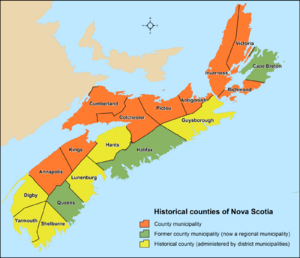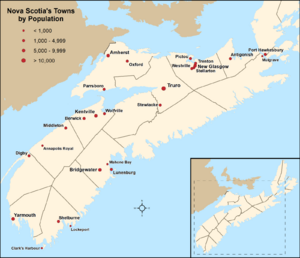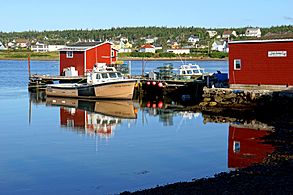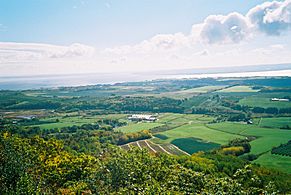List of municipalities in Nova Scotia facts for kids
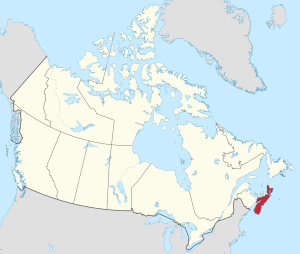
Nova Scotia is a province in Canada. It's the seventh most populated province, with about 969,000 people living there in 2021. It's also the second smallest province in terms of land area, covering about 52,824 square kilometers. Most of Nova Scotia's land (about 99.8%) is covered by its 49 municipalities. These municipalities are home to almost all of the province's population (about 98.7%).
Unlike some other Canadian provinces that have two levels of local government, Nova Scotia has a single system. This means there's just one main level of municipalities. These include four types: regional municipalities, towns, county municipalities, and district municipalities. These local governments follow rules from the Municipal Government Act (MGA), which started in 1999. This act gives municipal councils the power to make rules (called bylaws) to keep people and property safe and healthy.
Nova Scotia has 4 regional municipalities, 25 towns, 9 county municipalities, and 11 district municipalities. Halifax is the capital city and the largest municipality in Nova Scotia. It has about 439,000 residents, which is almost half of the province's total population. Halifax is also the largest by land area, covering about 5,475 square kilometers. The town of Pictou was the first municipality to be officially formed, back in 1874. The newest one is West Hants Regional Municipality, which was created in 2020 when two smaller areas joined together.
Contents
What are Regional Municipalities?
Regional municipalities are a type of local government in Nova Scotia. They are formed when all the smaller municipalities in a county agree to join together. The Nova Scotia Utility and Review Board (NSUARB) studies if this change would be good for the people living there. If it is, and if most voters agree, the regional municipality can be created.
Nova Scotia has four regional municipalities. Halifax is the biggest, both in population and land size. It's home to over 439,000 people. The Cape Breton Regional Municipality is the second largest, with about 93,000 people. The Region of Queens Municipality is the smallest regional municipality by population, and West Hants Regional Municipality is the smallest by land area. West Hants is also the newest regional municipality.
What are Rural Municipalities?
Rural municipalities in Nova Scotia are local governments for areas outside of towns. They were first set up in 1879. There are two types of rural municipalities: county municipalities and district municipalities. The difference between them depends on how the historical counties were divided in the past.
County Municipalities
Nova Scotia used to have 18 historical counties. Before 1879, local government was run by appointed courts. But on April 17, 1879, elected councils took over. This led to the creation of 12 county municipalities. The other 6 counties were divided into districts, which became district municipalities.
Over time, some of these 12 county municipalities changed. Three of them became regional municipalities in the mid-1990s. The remaining 9 county municipalities continue to operate under the Municipal Government Act. They provide local government services to people living in their historical county areas, but outside of incorporated towns.
The Municipality of the County of Kings is the largest county municipality by population, with about 47,900 residents. The Municipality of the County of Cumberland is the largest by land area. The Municipality of the County of Victoria has the fewest people, and the Municipality of the County of Richmond is the smallest by land area.
District Municipalities
Before elected local governments began in 1879, six of Nova Scotia's historical counties were split into smaller districts for court purposes. When local governments were formed, these six historical counties became 12 district municipalities, based on those old divisions. These district municipalities serve the people living in those areas, outside of towns.
On April 1, 2020, one district municipality, the Municipality of the District of West Hants, joined with the Town of Windsor to form a regional municipality. This reduced the number of district municipalities to 11. They continue to be governed by the Municipal Government Act.
The Lunenburg district municipality is the largest by population, with about 25,500 residents. The St. Mary's district municipality is the smallest by population. For land area, Guysborough is the largest, and Yarmouth is the smallest.
What are Towns?
In the past, areas could apply to become a town if they had enough voters. The Nova Scotia Utility and Review Board would review the application and decide if it made sense. However, in 2015, the rules changed. Now, no new towns can be officially formed in Nova Scotia.
In 2016, Nova Scotia had 27 towns. Since then, two towns have changed. The Town of Parrsboro no longer exists as a separate town, and the Town of Windsor joined with another area to form a regional municipality. This means there are now 25 towns in Nova Scotia. In 2021, these 25 towns had a total population of about 96,500 people.
Truro is the largest town by population, with nearly 13,000 residents. It's also the largest by land area. Lockeport is the smallest town by population, with only about 476 people. Annapolis Royal is the smallest town by land area.
List of Municipalities (Highlights)
-
Halifax is Nova Scotia's capital and largest municipality by population.
-
Harbour of Louisbourg in Cape Breton, Nova Scotia's second-most populated municipality.
Here are some of Nova Scotia's municipalities and their types:
- Cape Breton - Regional municipality
- Halifax - Regional municipality
- Queens - Regional municipality
- West Hants - Regional municipality
- Annapolis - County municipality
- Antigonish - County municipality
- Colchester - County municipality
- Cumberland - County municipality
- Kings - County municipality
- Argyle - District municipality
- Chester - District municipality
- East Hants - District municipality
- Lunenburg - District municipality
- Amherst - Town
- Annapolis Royal - Town
- Antigonish - Town
- Bridgewater - Town
- Kentville - Town
- New Glasgow - Town
- Truro - Town
- Yarmouth - Town
How Municipalities Change
Nova Scotia's local governments have changed over the years. Some municipalities have joined together, and others have stopped being separate towns.
Joining Together (Amalgamations)
Several municipalities have joined to form larger ones. For example:
- In 1995, the County of Cape Breton, the City of Sydney, and several towns combined to create the Cape Breton Regional Municipality.
- In 1996, the City of Halifax, the City of Dartmouth, the Town of Bedford, and the County of Halifax joined to form the Halifax Regional Municipality.
- Also in 1996, the County of Queens and the Town of Liverpool became the Region of Queens Municipality.
- Most recently, in 2020, the Town of Windsor and the Municipality of the District of West Hants merged to form the West Hants Regional Municipality.
Stopping Being Separate (Dissolutions)
Since 2011, five towns have dissolved. This means they are no longer separate towns and are now part of the larger rural municipalities around them.
- Canso dissolved in 2012 and became part of the Municipality of the District of Guysborough.
- Bridgetown and Springhill dissolved in 2015. Bridgetown joined the Municipality of the County of Annapolis, and Springhill joined the Municipality of the County of Cumberland.
- Hantsport became part of the Municipality of the District of West Hants in 2015.
- Parrsboro dissolved in 2016 and became part of the Municipality of the County of Cumberland.
See also
- Demographics of Nova Scotia
- Geography of Nova Scotia
- List of communities in Nova Scotia
- List of villages in Nova Scotia



